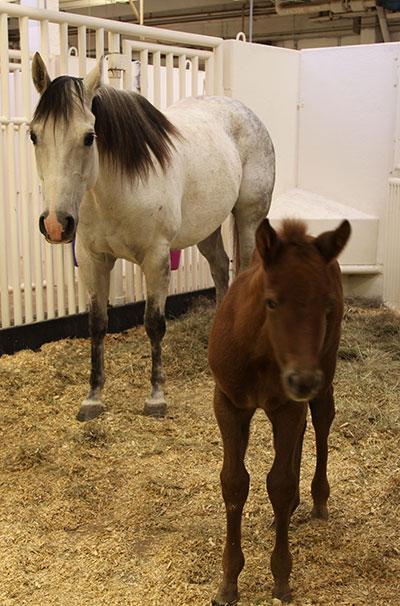
OSU Veterinarians Bring Mom and Baby Together
Tuesday, April 11, 2017
When a first-time mother foaled early and wouldn’t let the baby nurse, former OSU Big 12 defensive back Trent Alexander knew exactly where to turn—his alma mater. Alexander of Maramec, Okla., rushed the mare and her foal to Oklahoma State University’s Veterinary Medical Hospital for treatment.
“I’ve had race horses since I was eight years old,” explained Alexander. “I found the baby at 4:20 in the morning. She had foaled a week early so I really wasn’t expecting it. That same day I had to go to the race track to train horses at Remington. So when I came home that evening, the baby was weak, wasn’t standing. I could tell the mare hadn’t let her suck. So immediately, I caught the mare and milked her out. I called OSU and they told me to get her in right away. Time is precious in those moments to get colostrum to them to get the antibodies in them to fight off any type of infection. So I loaded them up in the trailer and I brought her here and I was immediately met with a team of five or six vets that put her in the ICU and began working on her.”
“When it (the foal) came in, it could hardly walk, really wobbly, shaky,” recalled Dr. Lyndi Gilliam, associate professor of equine internal medicine. “It could stand just for a few seconds on its own. It still really wanted to nurse. It was hungry but just couldn’t get everything quite coordinated and the mare had plenty of milk; she just wasn’t being very willing to share it with the baby. The foal’s blood sugar was really low, and by that time, it was a complete failure of passive transfer. It had no protective antibodies for about 8 hours. It had an infection in its blood stream already or evidence of that.”
The mare and foal were put in the Gaylord Neonatal Care Wing located in the hospital’s Gaylord Center for Excellence in Equine Health. Three ICU stalls have Dutch doors to allow critical care of the foal while providing the mare access via the top half of the gate. Veterinarians on the case took some blood samples for culture to see if there was bacteria in its blood stream. They started the foal on antibiotics and on fluid therapy. It was on pumps all night long as well as on oxygen for low oxygen levels in its blood.
“So for about 18 hours it was pretty much just down on the mat unable to get up,” continued Gilliam. “The mare actually would let us milk her so we could get plenty of her milk and feed it to the baby. And the baby was happy to drink it. In about 24 hours the baby was up on its feet and seeming a bit more normal. And then the job began of getting the mare to accept the baby. It took us about another 24 hours to get them acquainted to one another. Once she decided that was truly her baby and let it nurse, the foal has just really taken off from there. When we look at its lab work and how sick it was, it’s really pretty remarkable how quickly she’s turned around. I’m so excited she’s going home today.”
“We’re right at eight days and she’s ready to go home,” added Alexander. “They’ve got her over her bugs and she’s in great shape and so I’m happy. I’m happy about it. I put a lot of trust in OSU. I’ve used some other vets for other things when it’s not serious. But when it’s serious and I’ve got high caliber horses on the line, this is where I come.”
For more information on the services and facilities available, visit the Veterinary Medical Hospital website.
